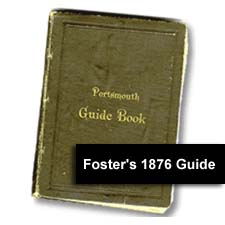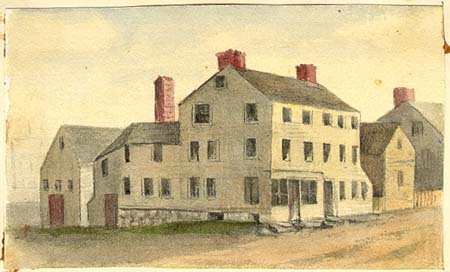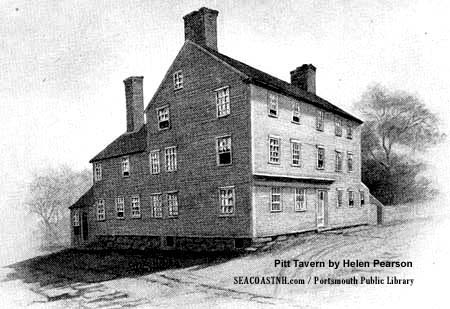| First Portsmouth Guidebooks |

WHEN HELEN MET SARAH
Portsmouth, NH has had many historic walking guides over the years. The first and perhaps best in 1876 was the inspiration of Sarah Haven Foster, a local artist and writer. Her independent work inspired artist Helen Pearson to create her own fragile guidebook in 1913. Both have largely faded from memory, but deserve a new look.
READ ABOUT: Every Portsmouth Guidebook
How come there's no guide book to historic Portsmouth? The city has plenty of summer visitors, dozens of historic and scenic spots " but no cheap pocket-sized tourist bible.
That fact was bugging Sarah Haven Foster as far back as the mid-1800s. The daughter of an upstanding Portsmouth family, Sarah knew what it meant to be a stranger in a strange town. From teenager to senior citizen, she loved exploring new destinations, creating poems and paintings as she traveled widely in the USA and abroad. Family letters show her touring Europe as early as the 1840s, a bold adventurous life for a girl of 16.
At home and abroad, Sarah Foster painted her heart out, mostly depicting wildflowers, pastoral scenery and architecture. She painted scores of historic buildings in the Seacoast region, often from many angles, returning time and again until she got the picture right. Today more than a thousand of her small watercolors are archived at the Portsmouth Public Library.

The more Sarah painted and studied, the more she became a walking textbook of local factoids. Never married, she devoted herself instead to preserving her nostalgic vision of colonial New England, even as the Industrial Revolution was reshaping the face of the land. The more times changed, the more she longed for the simple charm of the past as she imagined it and the more it bugged Sarah that Portsmouth lacked a decent affordable road map to the homes of the rich and famous.
Her creation, "A Portsmouth Guide Book", finally gelled in 1876, on the centennial of the founding of America, when Sarah was nearing 50 years old. Sarah Foster's book, containing nine narrated walking tours, became the city's first European-style guide. It was an instant bestseller, propelled, conveniently, by the fact that prominent local publisher Joseph Foster was Sarah's brother. It survived two more printings in 1884 and 1893, when a rash of fancy photographic guides began to appear.
Today the 167-page second edition, with its warped cloth cover pasted on a cardboard frame, looks fragile indeed. Not much larger than two decks of cards placed side-by-side, the little green guide was made purposefully cheap. Sarah wanted to reach everyone, particularly women, it can be assumed, to whom price may have been a barrier.
She was not above selling ads to bring down the price. The back of the 1884 edition contains paid promotions for "low cost choice flowers" from a local florist, and "room papers and spectacles" from her brother's printing shop at 1 Congress Street in Market Square. There are ads from two pharmacies, two hotels, a music store, a stove shop, a clothing store, ads for stereoscopic viewers, a boarding stable and for Miss Morgan's School for Young Ladies.
Like all Port City guides since, Foster borrowed facts heavily from the two weighty history volumes of Charles Brewster's "Rambles About Portsmouth" (1869) and the ancient leather-bound "Annals of Portsmouth" (1823) by Nathaniel Adams. Although she likely outsold her forebears, for reasons unknown, Sarah Foster's name does not appear as author of her popular guide.
Sarah Haven Foster's life ended abruptly, violently, ironically on the corner of Richards Ave. and Middle Street. On August 19, 1900 the 73 year old "grandmother of Portsmouth tourism was crossing the street in front of her home when one of the new-fangled trolley cars clanged past. Hard of hearing and with weak vision, Sarah Foster stepped across the track, unaware that a second trolley had been added to the line. She was struck and thrown a great distance, and later died of her injuries.
The sudden arrival of the high-tech 20th century caught Sarah Foster looking the other way. Her ephemeral pocket booklet was replaced in 1902 by a slick, thick photo-filled volume entitled "Gurney's Portsmouth: Historic and Picturesque." This industrial-strength encyclopedia catalogued every corner of 20th century Portsmouth from the first settler to the massive new Frank Jones Brewery. Sarah, the little old lady painter and writer, was forgotten and her guide book displaced.
But this story doesn't end there. Sarah's guide had a gentle child, of sorts, that arrived in 1913. Helen Pearson's "Vignettes of Portsmouth," almost equally forgotten today, seems a loving homage to Foster's ground-breaking guide. It has the same inexpensive cover, the same gothic type font, the same brief summaries and popular appeal.
What's different are the pictures. In an era enamored of photography and movies, Helen Pearson's "Vignettes" contained 23 soft evocative pencil drawings. Her detailed sketches have a near-photo quality that surprises viewers even today.
Was there a connection between Sarah and Helen? The library files are almost bare of details about either women other than their obituaries. (Foster died in 1900, Pearson in 1949.) No photograph or drawing of either woman is currently preserved. Like most local women of their time not born or married to well-known men, their lives have all but faded -- but not yet their work, which shows a kindred spirit too colorful to suppress. The connection between Helen and Sarah comes when we follow the flowers.
Hidden in the back of Ms. Foster's 1884 edition of the "Guide" are a number of advertisements -- a necessary evil if the book was to be sold cheaply and distributed widely among women. Included in those ads is one for a local florist " S.E. Pearson, with a greenhouse on Broad Street in Portsmouth. Broad Street was a short walk from Sarah's home on Richards Avenue. The florist was none other than Susan Pearson, mother of artist Helen Pearson.
Helen was about 14 years old when Sarah Foster visited her mother's green house. The girl must have been familiar with Sarah's paintings, perhaps she possessed a few and studied them as they hung on her bedroom wall. Perhaps Sarah saw in Helen an independent light that reminded her of her own bold teenage days when she first explored the world. We can only conjecture. But in an era when women's history was all but drowned out by the drumbeat of male dates and battles, dollars and documents, it pays to listen for soft voices. Listen harder to Helen and Sarah, and we hear a distant choir of women and children carrying the melody of history that fleshes out the mysterious song of life.
It's a fact that Helen Pearson attended Cowle Art School in Boston. Like Sarah Foster, she was multi-talented and became an accomplished artist. As a pianist, for a time, Helen performed with the Schenectady Symphony Orchestra. Ms. Pearson eventually took over her mother's greenhouse on Broad Street. Like Sarah, she never married, living on Broad Street until her death in 1949.
Portsmouth historian Dorothy Vaughan, who died just shy of her 100th birthday, recalled Helen Pearson vividly. Pearson's "Vignettes" was very popular when Ms. Vaughan began work at the library at age 21, a career that would span 54 years.
"I used to call on her," Vaughan told SeacoastNH. "She was a delightful woman with a sort of a flourish. She had a hot house on the back of her home on Broad Street where she lived with her brother Dan. They raised wonderful flowers."
Like her mother, Helen Pearson raised beautiful flowers, delicate flowers at discount prices. Like Sarah Foster, though their styles differ, Pearson also painted flowers " flowers and buildings " both strong and ephemeral in their own way. Both women wrote her own guide to the buildings in Portsmouth, discount guides whose leaves have gone brittle with age. And now, a century later, Portsmouth is again without a compact affordable guide for tourists. That would have bugged Sarah and Helen no end.
Meanwhile, their paintings survive. Dorothy Vaughan remembers them well. For decades people have rediscovered and admired them, but put them back. And so they remain. On the shelves of the Portsmouth Public Library, stacked in acid-free museum boxes, the collected houses and flowers of Helen and Sarah rest patiently, like two unflappable old friends, waiting to guide us through town again in a chorus of forgotten song.
Copyright © 2005 SeacaostNH.com. All rights reserved. First published online here in 1999.

